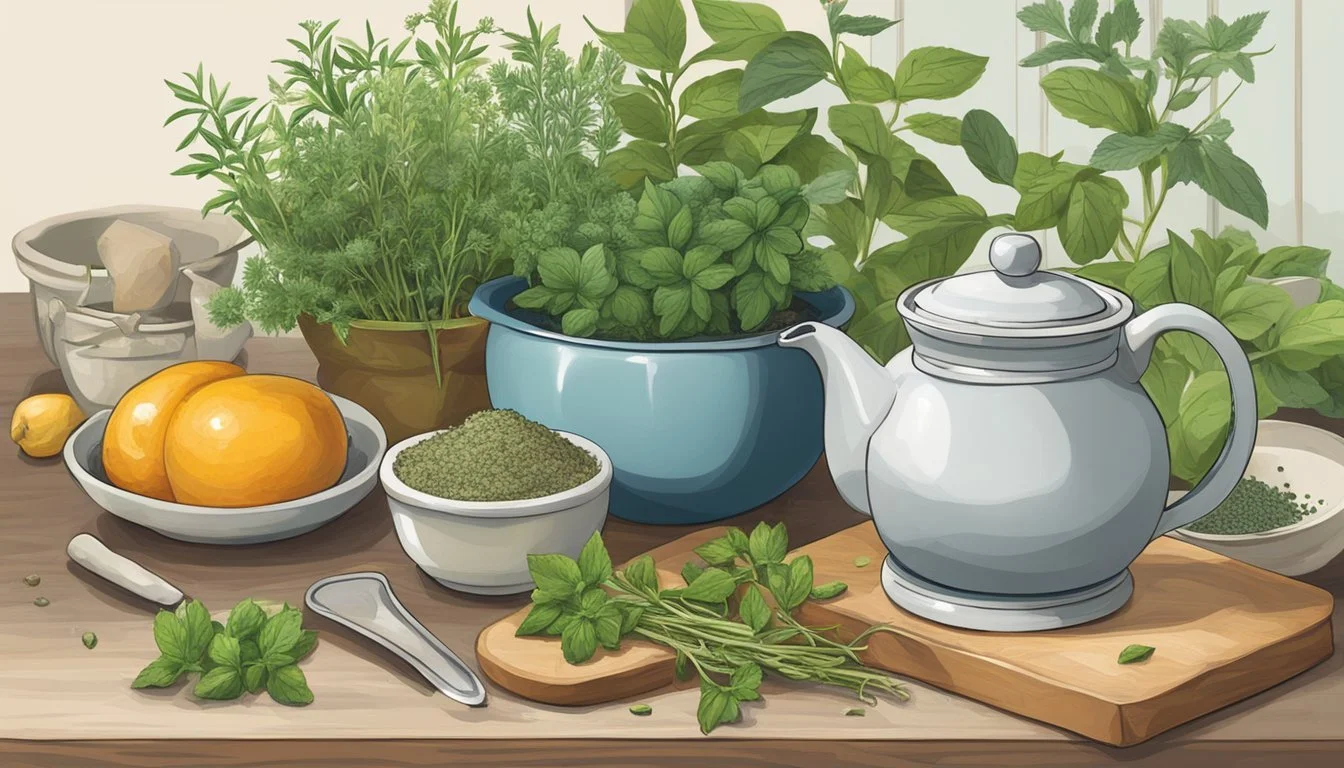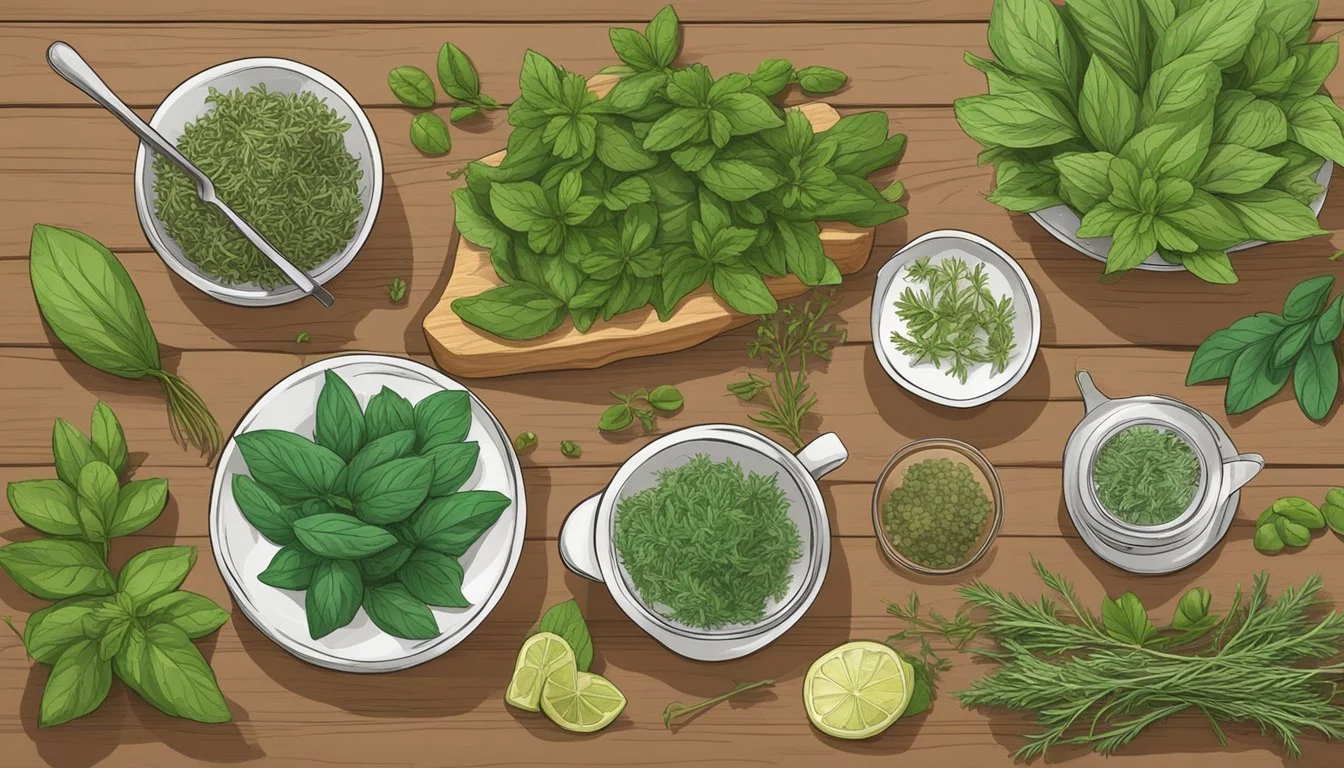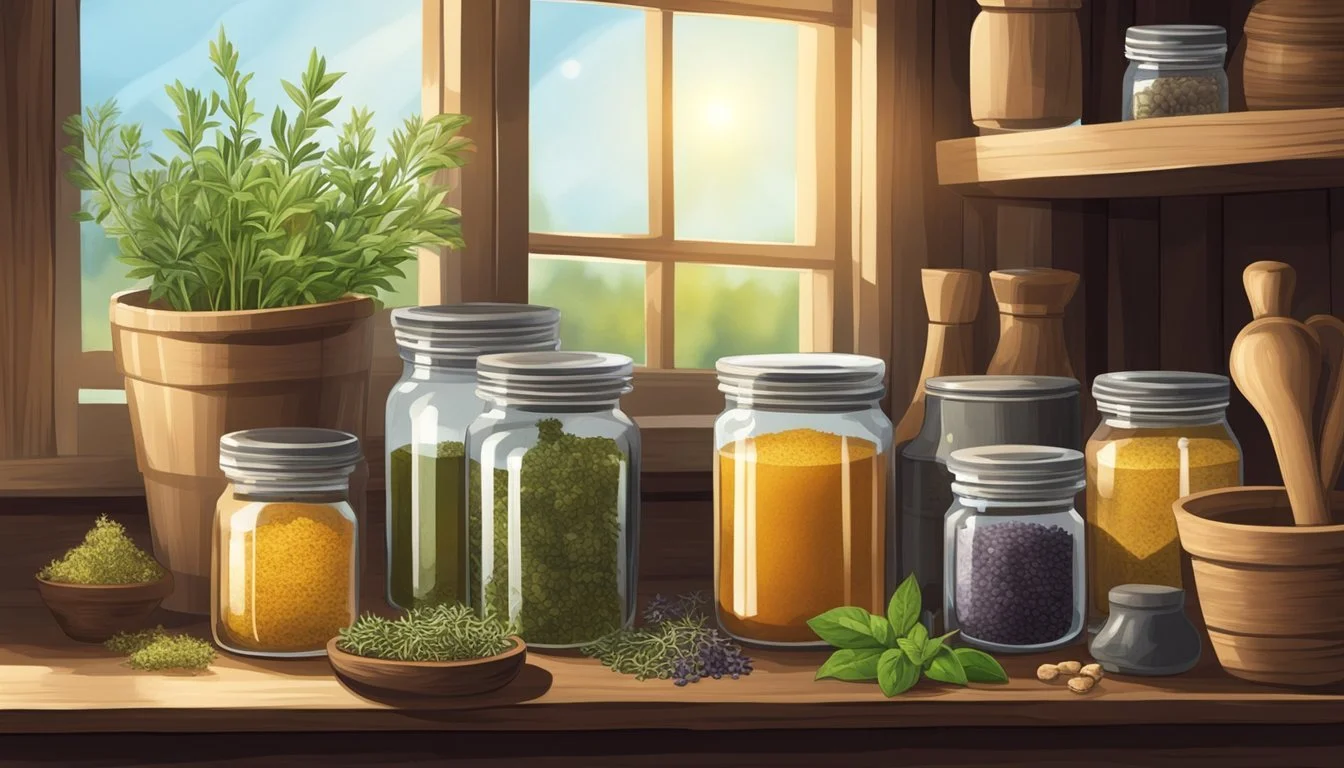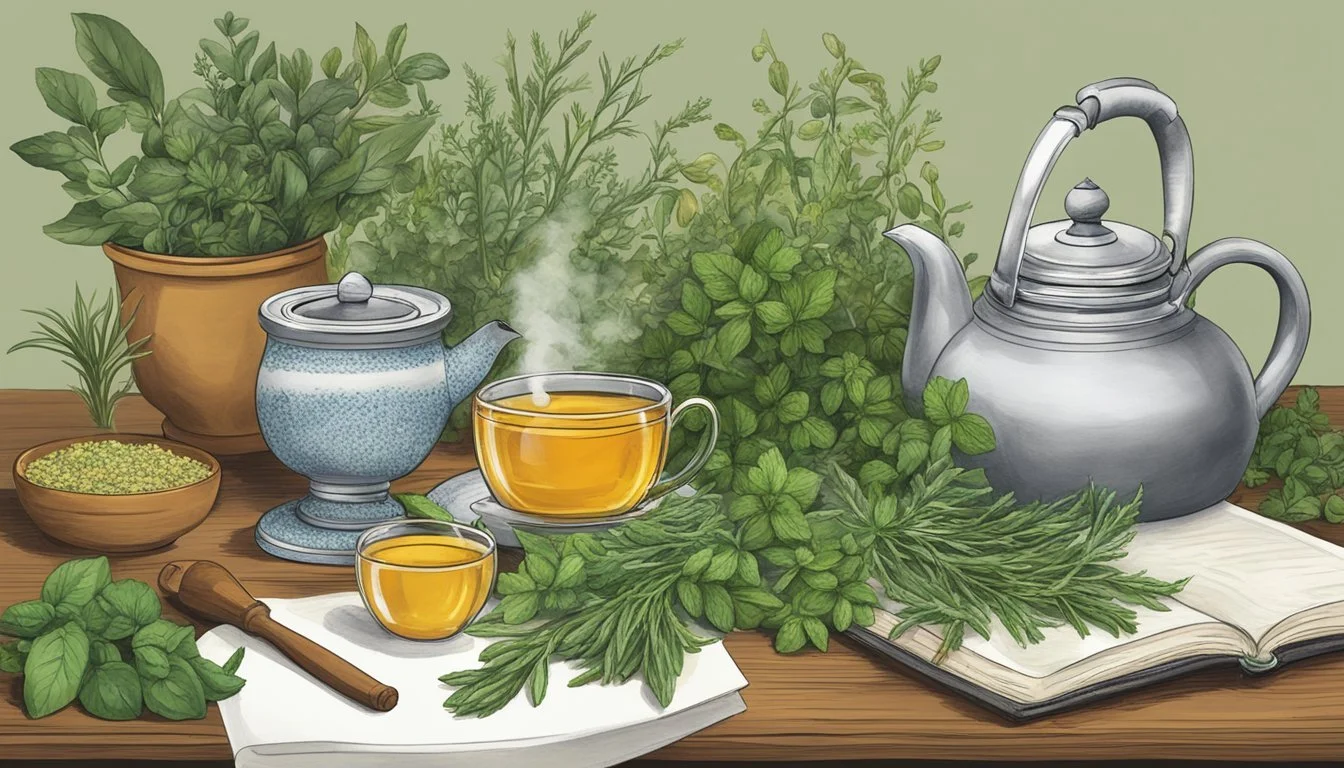How to Make Herbal Teas and Infusions with Farmers' Market Herbs
A Guide to Crafting Your Own Blends
Herbal teas and infusions offer a delightful spectrum of flavors and health benefits, and harnessing the freshness of farmers' market herbs can elevate the experience. Starting with fresh, locally sourced herbs, not only supports local agriculture but also ensures the potency of the natural compounds within the botanicals. Herbal teas, simple as they are to prepare, invite a moment of calm into a busy day and can be tailored to suit individual tastes or health needs.
Understanding the properties of each herb is key to creating effective and enjoyable teas and infusions. Echinacea, for example, is popular for its immune-boosting potential, particularly during cold and flu seasons, while nettle is lauded for its rich mineral content and support of joint health. The art of making herbal teas is accessible to everyone, and begins with selecting the right herbs for the desired effect, whether it's soothing relaxation or a boost in vitality.
Creating these infusions at home involves a few simple steps: boiling water to the necessary temperature, steeping the herbs for the right amount of time, and knowing whether to use the leaves, stems, flowers, or roots of the plant. Each part of the herb can yield different flavors and benefits, adding depth to the craft of at-home tea making. By using high-quality, fresh herbs (how long do fresh herbs last?) from farmers' markets, one ensures a more vibrant, flavorful, and nutrient-rich brew.
Understanding Herbal Teas and Infusions
Creating an aromatic and flavorsome herbal tea or infusion begins with the essentials: herbs gathered fresh from the farmers' market and the art of steeping them to draw out their potential benefits.
The Basics of Herbal Tea
Herbal teas and infusions are beverages made by steeping the leaves, flowers, stems, roots, berries, or bark of various herbs. The process starts with selecting high-quality herbs, which are often freshly sourced from farmers' markets. Key to their quality and efficacy is their freshness and how they've been grown and handled.
One prepares herbal teas typically by pouring hot water over the plant material and letting it steep for a period. The optimal temperature and steeping duration can vary depending on the type of herb used. Most herbal infusions require boiling water poured over the herb to ensure the release of its compounds. The herbs are then allowed to steep as they cool to room temperature.
Herbal Infusions differ slightly from teas in that they often involve a longer steeping time, allowing for a more concentrated brew. These can be either water-based or oil-based infusions. While water-based infusions are akin to herbal teas, oil-based infusions steep the herbs in oil, a process often used for topical applications.
When preparing either type, it is generally recommended to use about 1 teaspoon of dried herb or 1 tablespoon of fresh herb per cup of water. The steeping time can range from 5 to 15 minutes for herbal teas, while herbal infusions can steep for an extended period, sometimes hours, to extract the full range of benefits.
The variety in herbal components is vast, but common elements include:
Leaves: like peppermint and lemongrass, which steep quickly and provide a refreshing flavor.
Flowers: such as chamomile or hibiscus, known for their calming properties and vivid colors.
Roots: like ginger or turmeric, which may require a longer steeping time to harness their robust flavors and healthful attributes.
Berries/Bark: which often need the longest steeping times but impart deep, complex flavors and potential health benefits.
In summary, the diversity of herbal components, from leaves to roots, allows individuals to tailor their herbal tea experience to their specific taste preferences and wellness goals. With attention to quality and steeping techniques, one can unlock the natural essence and benefits of herbs.
Preparation of Herbal Teas
In crafting herbal teas and infusions from market-fresh herbs, one must consider herb selection, whether to use fresh or dried herbs, the impact of water quality on the brew, and the correct steeping methods to ensure the maximum therapeutic and flavor benefits.
Selecting Your Herbs
Selecting the right herbs is paramount. Common choices include mint for a refreshing note, chamomile for its soothing properties, peppermint for digestion, lavender for relaxation, ginger for warmth and spice, thyme for its aromatic essence, echinacea for immune support, and nettle for its nutrient-rich profile. Farmers' markets often provide the freshest options, picked at their peak for the most potent oils and benefits.
Fresh vs. Dried Herbs
The choice between fresh and dried herbs influences the intensity of the tea. Fresh herbs, usually more subtly flavored, require a larger quantity in an infusion than their dried counterparts. Dried herbs, having a concentrated flavor and essential oils, are potent even in smaller amounts. For instance, one tablespoon of fresh herbs typically equates to one teaspoon of dried.
Water Quality and Temperature
The quality of water used in the tea has a direct effect on the infusion's taste and color. Purified or spring water free of chemicals and heavy minerals is ideal. The temperature of the water is crucial – boiling water is best for hard components like seeds or roots, while just below boiling suits delicate leaves and petals to prevent burning the herbs and losing subtle flavors.
Proper Steeping Techniques
Steeping is the heart of making an herbal infusion. A general method involves boiling water, then pouring it over the herb mixture, whether in a teapot, glass jar, or direct in a mug, and covering it to steep. Leaves and flowers benefit from steeping for 5 to 10 minutes, while seeds and roots can steep up to 20 minutes for full extraction.
Example of Steeping Time for Common Herbs:
Mint, Chamomile, Lavender: 5-7 minutes
Ginger, Thyme: 10 minutes
Echinacea, Nettle: 15-20 minutes
Using the correct technique ensures that the water is appropriately infused with the herbs' oils and flavors, making a well-prepared and beneficial herbal tea.
Herbal Tea Equipment
Proper equipment is key to making exceptional herbal teas and infusions. It ensures convenience, flavor retention, and ease of preparation.
Choosing the Right Strainer
Strainers are essential for separating the leaves from the liquid, providing a clear, enjoyable tea. The tea ball is a common tool, suited for individual servings and keeping loose leaves contained. Alternatively, a fine mesh strainer can handle larger volumes, ideal for pots, and ensures even the smallest particles are filtered out. One should opt for stainless steel varieties for their durability and ease of cleaning.
Infuser or Tea Ball: It’s compact, easy to use, and great for a single cup.
Fine Mesh Strainer: Best for larger batches; fits over mugs and pots alike.
The Role of Teapots and Kettles
Teapots and kettles serve different but complementary roles in the tea brewing process. A kettle is employed for heating water and should be sturdy with a spout that allows for safe, precise pouring. Teapots, traditionally ceramic or glass, are for the actual steeping and serving of the tea. A glass container serves a dual purpose for sightly steeping infusions and seamless transitions to serving. They should have a snug-fitting lid to trap heat and the essential volatile oils from the herbs.
Kettle: Should be reliable with a controlled pour; electric versions provide precision.
Teapot: Ceramic retains heat well, while glass offers a visual appeal.
Glass Container: Ideal for infusions; airtight seals improve flavor concentration.
Types of Herbal Tea and Their Uses
Herbal teas, crafted from an array of farmers' market herbs, can serve as both a delightful beverage and a traditional remedy for various ailments. This section delves into the variety of herbs commonly used in these teas and how specific blends can address health concerns.
Common Herbal Tea Varieties
Mint Tea: Often made from peppermint or spearmint, this tea is renowned for its refreshing flavor. It can aid in relieving symptoms of an upset stomach and promote digestion.
Chamomile Tea: Chamomile is celebrated for its calming properties, making it a popular choice for those dealing with anxiety or seeking a natural sleep aid. It also possesses anti-inflammatory properties that can soothe minor health complaints.
Lavender Tea: With a distinctive floral aroma, lavender tea is another brew that may help alleviate anxiety and stress. Its soothing qualities are also known to support sleep.
Ginger Tea: Ginger's potent anti-inflammatory effects and its ability to relieve nausea make it a staple for those with an upset stomach, especially during cold and flu season.
Herbal Blends for Specific Ailments
Cold and Flu Relief: A blend of peppermint, elderberry, echinacea, and ginger can support the immune system and help alleviate symptoms associated with the cold and flu.
Digestive Support: Combining peppermint, chamomile, and ginger can provide a holistic approach to easing digestive discomfort and reducing inflammation.
Stress and Anxiety: A calming herbal tea blend might include chamomile, lavender, and lemon balm, all known for their relaxation-inducing effects on the body and mind.
Holistic Health Maintenance: A daily infusion of a variety of herbs such as nettles, dandelion, and red clover can support overall wellness and maintain a balanced immune response.
Creating Herbal Infusions
Creating an herbal infusion involves steeping herbs in either hot or cold water to extract their flavors and beneficial properties. The quality of the final beverage depends on the proper execution of these methods.
The Infusion Process
An infusion is typically made by steeping herbs in hot water, which extracts the herbs' flavors, aromas, and compounds. The process is as follows:
Herb-to-Water Ratio: Use one teaspoon of dried herbs or two teaspoons of fresh herbs per one cup of hot water.
Heating Water: Heat water until it reaches a rolling boil, a critical step as hot water breaks down the cell walls of the herbs rapidly, resulting in an effective infusion.
Combining Ingredients: Place the herbs in a heatproof container, such as a glass jar or teapot.
Steeping: Pour the boiling water over the herbs and cover the container with a tight-fitting lid to prevent the escape of steam and volatile oils.
Duration: Let the mixture steep. The exact time may vary based on the type of herb and desired strength, but it commonly ranges from 5 to 15 minutes.
Cold Water Infusions
Cold water infusions are a gentler method of extracting flavors and healing properties from herbs. They are well-suited for more delicate herbs or when a less intense flavor is desired.
Herb Preparation: Bundle the herbs in cheesecloth or a muslin bag. Slightly moisten the bag to help the herbs submerge easier.
Water: Fill a jar with cold, fresh water and submerge the bundle just below the surface.
Refrigeration: Place the infusion in the refrigerator, allowing it to steep slowly, usually overnight.
Sunlight Option: Another method is to place the jar in direct sunlight for a period of time, known as sun infusion, which can speed up the process without heat.
Maximizing Health Benefits
In the pursuit of health and wellness, incorporating herbal teas and infusions made from farmers' market herbs can be a wise choice. These beverages not only offer soothing flavors but are also enriched with essential nutrients that can enhance overall health.
Nutritional and Medicinal Properties
When selecting herbs for teas and infusions, focusing on their nutritional and medicinal properties enables individuals to maximize the health benefits. Here is a guide to some of the key components:
Vitamins: Many herbs contain vital vitamins that support bodily functions. For instance, Vitamin C, known for its immune-boosting effects, is found in herbs like lemon balm and rosehips.
Minerals: Essential minerals such as calcium, which is fundamental for bone health, and iron, crucial for oxygen transport, are present in herbs like nettle and dandelion.
Antioxidants: Herbs are often rich in antioxidants. These beneficial compounds can neutralize harmful free radicals, potentially reducing the risk of chronic diseases. Examples include the antioxidants found in green tea leaves and hibiscus.
Anti-inflammatory Properties: Chronic inflammation can lead to various health issues. Herbs such as ginger and turmeric are renowned for their anti-inflammatory effects, which may help alleviate conditions like arthritis.
To optimize the intake of these important nutrients, consider the following:
Freshness: Herbs are most potent when fresh. Choose herbs that look vibrant and smell strong, which indicate they retain their beneficial compounds.
Preparation: Proper preparation of herbal teas can influence their health properties. For instance, gentle simmering of roots and leaves can extract more nutrients compared to steeping.
Combination: Combining herbs can enhance their individual effects. Understand the synergy between different herbs to create a more potent infusion.
By focusing on the nutritional and medicinal properties of herbs, one can craft herbal teas and infusions that are not only comforting but also beneficial for health. They can help provide essential vitamins, minerals, antioxidants, and anti-inflammatory agents which may support memory, reduce inflammation, and contribute to overall vitality.
Storing Herbal Teas and Infusions
Proper storage is essential to maintaining the freshness and efficacy of herbal teas and infusions made using herbs from the farmers’ market.
Proper Storage Techniques
When storing herbal teas and infusions, it is vital to protect them from air, light, and heat, which can all degrade the quality of the herbs. They should be kept in airtight containers made of non-reactive materials such as glass or tin. Using opaque containers or storing them in a cool, dark cupboard further shields them from damaging light.
For the refrigerator, it's recommended to store the infusions in covered glass or BPA-free plastic containers. It’s important to label each container with the name of the herb and the date of storage. Herbal teas and infusions should be cooled to room temperature before refrigerating to prevent condensation inside the container, which could lead to spoilage.
Longevity and Preservation
The shelf life of dried herbal teas and infusions can be quite long if stored correctly:
Dried loose leaf teas: Typically can last up to 2 years if stored in a cool, dry place away from direct sunlight.
Fresh herbal infusions: Should generally be consumed within 24 to 48 hours, or as per the preparation's specific recommendations.
For maximum longevity:
Always use clean, dry utensils when handling the herbs and infusions to prevent the introduction of moisture.
Store infusions in the refrigerator if they won’t be consumed immediately to slow down microbial growth and maintain freshness.
Freeze any unused portion of the infusion in ice cube trays for long-term storage. Once frozen, transfer the cubes into airtight bags or containers to prevent freezer burn.
By adhering to these specific guidelines, one can ensure that the herbal teas and infusions retain their intended flavor and beneficial properties for as long as possible.
Enhancing Flavors and Aromas
In crafting herbal teas and infusions, the choice of natural sweeteners and additives can significantly elevate the flavors and aromas inherent in farmers' market herbs. Here's how to enhance your herbal brews.
Natural Sweeteners and Additives
Honey: Raw honey is a superb natural sweetener that not only adds a rich, earthy sweetness but also complements the natural fragrance of herbs.
Citrus: A zest of lemon or a dash of lemon juice can brighten the flavors and marry well with herbs, especially those like lemon balm with its own citrusy profile.
Incorporating these natural enhancers allows the aromatic oils within the herbs to release more effectively, resulting in a more flavorful and fragrant experience.
Serving Suggestions for Enjoyment
Temperature: Serve hot to enjoy the full spectrum of aromas as the steam carries the scents.
Glassware: Choose transparent glassware to appreciate the color and clarity of the infusion.
A well-crafted herbal tea or infusion should be an indulgence for all the senses, and these suggestions aim to optimize the enjoyment of every sip.
Herbal Tea Recipes
Creating your own herbal tea blends and infusions is a delightful way to enjoy the bounty of farmers' market herbs. These recipes provide a comforting, aromatic experience that can be enjoyed any time of the day.
Step-by-Step Herbal Tea Recipes
To craft a basic herbal tea blend, one can follow these simple steps:
Choose your base herbs such as mint or chamomile, which will form the primary flavor of the tea.
Add accent herbs or flavors like lemon slices or cinnamon for complexity.
Combine approximately 1 tablespoon of the mixed herbs per cup of boiling water.
Steep for 5 to 10 minutes, depending on desired strength.
Strain and serve, optionally sweetening with honey or sugar.
A sample blend could include:
1 part chamomile
1 part lemon balm
A few lemon verbena leaves (for a citrus note)
Herbal infusions, which are stronger than teas, can be made as follows:
Select nutritive herbs such as dried nettle leaf, oatstraw, or tulsi.
Place approximately 1/2 to 1 cup of dried herbs into a quart-sized glass jar.
Pour boiling water over the herbs until the jar is full.
Cover with a tight-fitting lid and let steep for 4 hours or overnight for a potent infusion.
Strain the herbs and refrigerate the liquid. Consume within a day or two for best quality.
Here's a nutritive herbal infusion recipe:
1/2 cup dried nettle leaf
1/4 cup dried oatstraw
2 tablespoons dried rose hips
These recipes rely on the simplicity of ingredients and the inherent properties of the herbs. One can experience wellness benefits and the natural flavor profiles of various herb combinations with each blend or infusion. Whether one seeks relaxation, invigoration, or support for digestion, the perfect herbal tea recipe awaits.
Safety and Considerations
When crafting herbal teas and infusions with herbs from the farmer’s market, it is crucial to be cognizant of safety and the potential for allergic reactions or contraindications, especially during pregnancy.
Understanding Potential Allergies
Individuals should be aware that allergies to certain herbs can pose serious health risks. Before consuming an herbal tea, one must ensure they are not allergic to any of the components. Symptoms of an allergic reaction can include:
Hives or a rash
Difficulty breathing
Swelling of the mouth or throat
If a person experiences these symptoms, they should discontinue use immediately and seek medical attention. In addition, a healthcare provider can perform allergy tests if one is unsure about potential sensitivities.
Pregnancy and Herbal Tea Safety
The use of herbal teas during pregnancy requires cautious consideration. Certain herbs can affect hormone levels and even stimulate uterine contractions, which might be unsafe. It is essential for pregnant individuals to consult with a healthcare provider before consuming herbal teas. Some herbs to avoid during pregnancy include but are not limited to:
Comfrey
Goldenseal
Wormwood
Sage
Conversely, there are herbs commonly regarded as safe during pregnancy, such as ginger and peppermint, which can help alleviate morning sickness and digestive discomfort. However, moderating intake and seeking medical advice is always advised.
Advancing Your Herbal Tea Knowledge
To elevate their understanding and craft of herbal tea-making, readers should consider mastering sophisticated brewing methods and actively participating in the herbal tea community for an exchange of knowledge and experiences.
Exploring Advanced Brewing Techniques
Advanced brewing techniques can dramatically improve the quality of herbal teas. For instance, accurate measuring of herbs can lead to more consistent results; using a scale to measure by weight, as opposed to volume, ensures precision. The water temperature and steeping time are also critical factors; some herbs release more essential oils and flavors at certain temperatures and may require longer infusion times. Cold brewing is another method that can extract a different flavor profile and may be gentler on delicate herbs.
Infusion methods to consider:
Hot Infusion: Pouring boiling water over herbs and steeping for a specific duration.
Cold Infusion: Soaking herbs in cold water for an extended period, often several hours to overnight.
Decoction: Simmering tougher herbs like roots and barks to extract beneficial compounds.
Remember that the quality of water used in brewing can affect taste. Filtered or spring water is often recommended to ensure that the water's flavor does not overpower the delicate nuances of the herbs.
Joining the Herbal Tea Community
Becoming part of the herbal tea community can offer substantial learning opportunities. One can join local clubs or online forums dedicated to herbal teas, where members share their brewing techniques, experiences, and advice. These communities foster an environment where both beginners and experts can learn from each other.
Resources for community engagement:
Local workshops or classes: These often provide hands-on experience and direct interaction with knowledgeable instructors.
Social media groups: Platforms like Facebook or Reddit have specialized groups focused on herbal tea enthusiasts.
Tea festivals and fairs: Attending these events can provide access to a wide variety of herbs and blends, as well as workshops conducted by experts.








